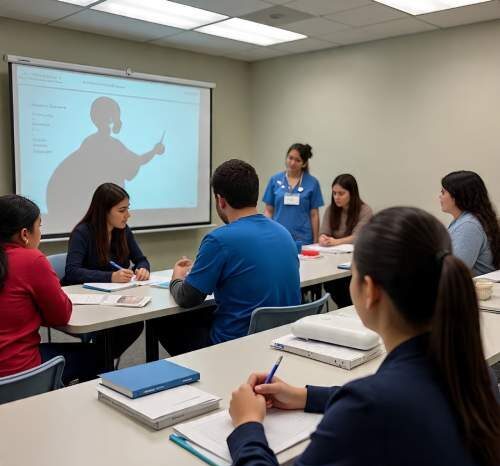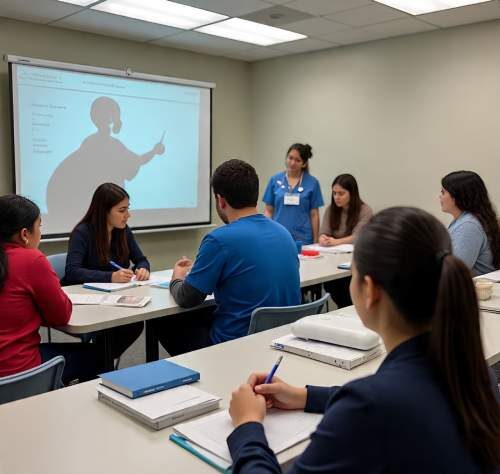Best Nursing Bridge Programs for Foreign nurses in USA 2025
nursing bridge programs for foreign nurses in USA 2025

If you’re an internationally educated nurse hoping to practice in the U.S., the best nursing bridge programs for foreign nurses in USA 2025 offer a streamlined pathway to RN licensure and career advancement, without repeating years of clinical training. These programs are designed specifically to help foreign-educated LPNs, RNs, or BSN holders transition into the U.S. healthcare workforce by bridging gaps in education, licensing, and practice requirements.

Nursing bridge programs for foreign nurses in USA 2025 recognize your prior learning and experience, allowing you to fast-track your way to becoming a licensed U.S. Registered Nurse. Whether you’re moving from LPN to RN, RN to BSN, or even pursuing an RN to MSN pathway, these flexible programs award credit for hands-on skills and prior education. In many cases, you can complete your bridge in half the time of a traditional degree—especially if you already meet clinical competency benchmarks.
The benefits go beyond speed. Graduates of these bridge programs often enjoy significantly higher salaries, greater job flexibility, and access to specialized roles in ICU, emergency care, pediatrics, or advanced nursing practice. Many of the nursing bridge programs for foreign nurses in USA 2025 are delivered through hybrid or fully online formats, allowing you to work while completing coursework and clinical hours on weekends, evenings, or during short in-person intensives.
In this comprehensive guide, we’ll walk you through everything you need to know about nursing bridge programs for foreign nurses in USA 2025—including program types (like RN-to-BSN or RN-to-MSN), tuition costs, timelines, visa-friendly schools, licensing hurdles, and how to choose a program that fits your goals and background.
What Are Nursing Bridge Programs?
Nursing bridge programs for foreign nurses in USA 2025 are specialized educational pathways that help internationally trained nurses and other healthcare professionals advance their U.S. nursing credentials efficiently—without starting their education from scratch. These programs are tailored to recognize your previous education, licensing, and clinical experience, allowing you to “bridge” to the next level of nursing with minimal redundancy.
For example, a licensed practical nurse (LPN) from overseas can enroll in an LPN-to-RN bridge program, fast-tracking their journey to becoming a Registered Nurse (RN) in the United States. Likewise, a foreign-educated RN with a diploma can transition into a Bachelor of Science in Nursing (BSN) or even a Master of Science in Nursing (MSN) program through targeted bridge options.
The strength of nursing bridge programs for foreign nurses in USA 2025 lies in their flexibility and speed. Many programs offer accelerated formats, credit for prior learning (CPL), and flexible schedules—including evening, weekend, hybrid, and online classes—making them ideal for working professionals or newly arrived international nurses managing other responsibilities like employment or licensure preparation.
Rather than repeating the basics, bridge programs emphasize new competencies required for higher nursing roles. For instance, an RN-to-BSN program may skip foundational clinical skills (which you already have) and focus instead on advanced coursework in nursing leadership, research, public health, and care coordination.
Why Do Foreign and U.S.-Based Nurses Pursue Bridge Programs?
Whether you’re a local CNA looking to become an RN or a foreign nurse aiming to meet U.S. licensure standards, nursing bridge programs for foreign nurses in USA 2025 provide a range of benefits—both professional and personal. Here’s why more nurses are choosing these accelerated pathways:
1. Career Advancement Without Starting Over
The clearest benefit of nursing bridge programs is advancement. A foreign-trained nurse may already have years of experience—but U.S. licensure often requires bridging to match local academic standards. Bridge programs help you move upward from roles like CNA to LPN, LPN to RN, or RN to BSN/MSN without having to repeat foundational training. This targeted progression makes it faster to qualify for advanced roles in critical care, leadership, or specialty areas like pediatrics or oncology.
2. Higher Earning Potential
Credential upgrades usually lead to increased income. For example:
An LPN who becomes an RN can boost their average salary by over 60%
An RN who completes a BSN bridge may see up to a 20% raise
A foreign nurse who bridges into the U.S. system can unlock salary ranges not accessible with only overseas credentials
Nursing bridge programs for foreign nurses in USA 2025 allow you to tap into these financial rewards quickly—especially since many programs recognize and honor your clinical experience from abroad.
3. More Job Opportunities and Visa Sponsorship
U.S. hospitals, especially Magnet-status institutions, increasingly require RNs to have BSN degrees. Bridge programs open access to these in-demand positions. Additionally, nurses with higher credentials are more likely to be eligible for:
Specialty roles (ICU, ER, OR)
Leadership and educator positions
Advanced practice roles (for MSN holders)
For international nurses, higher qualifications through bridge programs can also improve your eligibility for visa sponsorships or permanent residency under EB-3 and other healthcare immigration categories.
4. Time and Cost Efficiency
Unlike traditional nursing degrees that can take 3–4 years, nursing bridge programs for foreign nurses in USA 2025 often run between 12 and 24 months depending on your starting point and previous education. Because these programs award credit for prior learning or work experience, you avoid unnecessary coursework and tuition fees.
Many bridge programs also offer:
Online and hybrid formats
Rolling admissions
Pay-as-you-go tuition
Clinical placements near your home or workplace
This makes them cost-effective and convenient—ideal for busy professionals and newcomers to the U.S.
5. Greater Personal Fulfillment
For many nurses—especially those who have already overcome the challenges of working internationally—completing a bridge program is more than just a credential. It’s a symbol of growth, determination, and resilience. Whether your goal is to work in a top-tier U.S. hospital, become a nurse educator, or simply prove your capability, bridge programs provide a structured and rewarding path forward.
What Are Nursing Bridge Programs for Foreign Nurses in USA 2025?

Nursing bridge programs for foreign nurses in USA 2025 are specialized academic pathways designed to help internationally educated nurses seamlessly transition into the U.S. nursing workforce. These programs recognize your previous clinical training, licensure, and healthcare experience—allowing you to advance your credentials without restarting from the beginning.
Whether you’re a licensed nurse from the Philippines, India, Nigeria, or the U.K., these bridge programs help you match U.S. academic and licensure standards efficiently. For example, a foreign-trained Licensed Practical Nurse (LPN) can enroll in an LPN-to-RN bridge program, while an internationally educated RN can enter a BSN or MSN track, bypassing redundant coursework.
Unlike traditional nursing degrees, nursing bridge programs for foreign nurses in USA 2025 are structured to save you time and resources. They often grant credit for prior learning (CPL) and are designed with flexibility in mind—offering online, hybrid, weekend, or evening classes to accommodate working professionals or new immigrants managing multiple responsibilities, such as employment or immigration processes.
These bridge programs don’t waste time reteaching foundational skills. Instead, they focus on the advanced competencies required for U.S. practice—such as healthcare laws in America, clinical reasoning, nursing research, leadership, and specialized patient care. Programs like RN-to-BSN or RN-to-MSN are tailored to upgrade your clinical and academic qualifications while aligning with U.S. licensure requirements.
Why Foreign and U.S.-Based Nurses Choose Nursing Bridge Programs
Whether you’re already practicing in the U.S. as a CNA or LPN, or you’re a nurse newly arriving from abroad, nursing bridge programs for foreign nurses in USA 2025 offer tremendous benefits in terms of career growth, income potential, and job flexibility. Here’s why thousands of international nurses choose these accelerated academic tracks:
1. Career Advancement Without Repeating Education
One of the strongest advantages is the ability to move up the career ladder without starting over. A nurse trained overseas may have years of practical experience but still need to meet U.S. academic benchmarks for roles like Registered Nurse (RN) or Advanced Practice Registered Nurse (APRN). Bridge programs allow you to convert existing qualifications into U.S.-approved credentials quickly.
For instance:
A foreign LPN can upgrade to RN status.
A diploma-holding RN from another country can pursue a BSN or MSN in the U.S.
A paramedic or allied health professional can transition into nursing leadership roles.
This structured, step-up format saves time and positions you for immediate advancement in clinical roles or even academic and leadership paths.
http://”https://www.realnursingjourney.com/nclex-for-foreign-nurses-2025″
2. Higher Salary Potential
Upgrading your nursing license in the U.S. almost always translates to a significant income boost. Consider the following average increases:
LPN to RN: ~60% salary increase
RN to BSN: ~20% increase
Foreign nurse credentialed to U.S. RN: Eligibility for high-paying hospital jobs, specialty units, and visa-sponsored employment
Nursing bridge programs for foreign nurses in USA 2025 give you access to these earnings faster than traditional nursing degrees, especially since you already bring real-world experience to the table.
3. Better Job Opportunities and Immigration Support
As U.S. healthcare systems become more competitive and specialized, hospitals now prefer or require BSN-level or higher credentials, particularly those seeking Magnet hospital status. Bridge programs enable you to qualify for:
Critical care and ER roles
Community and public health nursing
Nurse educator or clinical instructor positions
Advanced practice roles (e.g., Nurse Practitioner with MSN)
Additionally, higher qualifications can help international nurses secure visa sponsorships such as EB-3 or H-1B, offering a direct path to permanent residency in the U.S. Some bridge programs even assist with visa paperwork or partner with employers offering sponsorship.
4. Cost and Time Efficiency
Unlike full nursing degrees that take 3–4 years, nursing bridge programs for foreign nurses in USA 2025 are often completed in 12–24 months. They are:
Accelerated: Transfer credits from prior degrees or licenses
Affordable: Many offer pay-per-credit or installment tuition models
Flexible: Choose online, evening, or weekend courses that fit your schedule
Practical: Local clinical placements available in your area or state
Many programs also waive clinical requirements already fulfilled overseas, dramatically reducing both education cost and time commitment.
5. Personal Growth and Professional Confidence
Finally, bridge programs offer more than a credential—they represent achievement and progress. For foreign-trained nurses, completing a bridge program can validate years of international work, proving you can thrive in the U.S. system. It also empowers you to take on more responsibility, influence patient care quality, and build a respected professional legacy.
Whether your goal is to lead a clinical team, teach at a nursing college, or specialize in cardiac care or pediatrics, nursing bridge programs for foreign nurses in USA 2025 offer a clear, efficient pathway.
2. LPN-to-RN Bridge Programs for Foreign Nurses in USA 2025
For internationally trained nurses currently working as Licensed Practical Nurses (LPNs) or Licensed Vocational Nurses (LVNs), the LPN-to-RN pathway is one of the most powerful nursing bridge programs for foreign nurses in USA 2025. It provides a direct route to becoming a Registered Nurse (RN)—without starting from scratch.
This bridge program recognizes your clinical experience and prior education, allowing you to transition into higher roles with broader authority, higher pay, and a wider range of career opportunities. As an RN, you’ll be qualified to assess patients independently, develop care plans, manage IV therapy, and supervise LPNs and CNAs. You’ll also become eligible for advanced certifications, better shift options, and jobs in high-demand specialties.
From → To
| Starting Role | Target Credential |
|---|---|
| Licensed Practical/Vocational Nurse (LPN/LVN) | Registered Nurse (Associate or Bachelor’s Degree – ADN or BSN) |
Duration of LPN-to-RN Bridge Programs
LPN-to-RN nursing bridge programs for foreign nurses in USA 2025 vary in length depending on the degree type and whether you’re studying full- or part-time.
LPN-to-ADN (Associate Degree in Nursing)
Length: Typically 12–18 months full-time; 2 years part-time
Many community colleges offer “advanced standing” or credit for prior LPN coursework, allowing you to complete your RN associate degree in less time.
Some programs offer a required “bridge” or “transition” course before diving into advanced nursing courses.
LPN-to-BSN (Bachelor of Science in Nursing)
Length: Usually 2–3 years depending on the curriculum
Accelerated LPN-to-BSN tracks are available online and on campus
Provides a stronger foundation for leadership roles, public health, and eventual graduate studies (like Nurse Practitioner or MSN)
Both bridge options are significantly faster than starting an RN program from zero. As a licensed LPN with international training, you’ll likely skip prerequisites and basic clinical skills, focusing instead on the core RN competencies.
Cost of LPN-to-RN Bridge Programs
Nursing bridge programs for foreign nurses in USA 2025 come with different price tags depending on institution type and whether you pursue an ADN or BSN.
| Bridge Path | Typical Tuition | Notes |
|---|---|---|
| LPN-to-ADN | $6,000 – $30,000 (most fall between $10k–$20k) | Community colleges offer affordable options, and LPN credits reduce time/cost. |
| LPN-to-BSN | Public in-state: $20,000 – $40,000 Private: $50,000 – $100,000+ | More expensive due to longer curriculum; advanced standing helps cut costs. |
Example: Indiana State University’s online LPN-to-BSN program reduces credit hours if you validate prior LPN coursework, trimming tuition fees significantly.
In addition to tuition, students should budget for:
Books and lab fees
Clinical supplies and uniforms
NCLEX-RN testing fees
Background checks and immunizations
Many LPNs continue working while in school, helping to offset expenses.
Financial Aid for LPN-to-RN Students

If you’re a foreign-trained LPN bridging to RN in the U.S., you’ll be happy to know that most accredited programs are eligible for financial aid. Here are your options:
Federal Student Aid: Pell Grants, Direct Loans
State Nursing Scholarships: Many states offer LPN-to-RN scholarships to help combat nurse shortages
Nursing Associations: Scholarships from organizations like the American Nurses Association (ANA), Minority Nurse, and others
Employer Tuition Reimbursement: Hospitals and care centers often support LPNs advancing their degrees, especially if you stay on post-graduation
Military Benefits: Veterans can use GI Bill funds for bridge programs
Loan Forgiveness Programs: Some states forgive nursing school loans if you work in underserved or rural areas as an RN
Pro Tip: Always check with your school’s financial aid office and explore nursing-specific grants and local options for foreign-trained professionals.
Why Choose an LPN-to-RN Program in 2025?
If you’re a foreign-trained nurse working as an LPN in the U.S., this bridge program is a strategic career move. With the growing demand for Registered Nurses nationwide, completing one of the nursing bridge programs for foreign nurses in USA 2025 sets you up for:
A salary increase of 50–70% or more
Greater job stability and visa sponsorship opportunities
Access to specialty roles in emergency, ICU, surgical, and pediatric care
The foundation to pursue BSN or MSN programs later on
Whether you opt for the quicker ADN path or the long-term benefits of a BSN, bridging from LPN to RN in 2025 will redefine your future in U.S. healthcare.
- RN-to-BSN Programs
RN-to-BSN bridge programs are commonly known as “completion” degrees. These programs are specifically designed for registered nurses who hold an associate degree (ADN) or a hospital diploma and are looking to obtain a Bachelor of Science in Nursing (BSN). It’s important to note that this pathway does not involve a new licensing exam — graduates remain Registered Nurses — but it does elevate their academic credentials and career potential.
A BSN is fast becoming the industry standard across many healthcare settings. Employers increasingly favor BSN-prepared nurses due to their broader knowledge in public health, evidence-based practice, research, leadership, and management. The RN-to-BSN curriculum focuses on these advanced areas, under the assumption that students already possess foundational clinical skills and active RN licensure.
From To
Registered Nurse (ADN or Diploma) Bachelor of Science in Nursing (BSN)
Duration
Most RN-to-BSN programs can be completed in about 12 months of full-time study. Common formats involve three continuous semesters (e.g., fall, spring, and summer). However, many institutions offer flexible, part-time options that extend over 18 to 24 months to accommodate working professionals.
Some accelerated online programs, like the one offered by the University of Texas at Arlington, can be completed in as little as 9 months with intensive, full-time enrollment. On the other hand, more flexible formats allow students to progress at their own pace, making it easier to balance work, school, and family commitments.
In general, a BSN degree requires about 120 total credits. Most RN-to-BSN students already have 60–70 credits from their previous nursing education. These bridge programs usually accept a substantial block of transfer credits and focus on upper-division nursing coursework. Typically, students complete an additional 30–36 credits that cover topics like nursing informatics, community health, healthcare policy, and leadership.
Some programs also offer credit for prior RN experience or professional training. A typical RN-to-BSN curriculum includes:
- Advanced Health Assessment
- Nursing Research and Evidence-Based Practice
- Community and Public Health Nursing
- Leadership and Management in Nursing
- Healthcare Policy and Ethics
- Nursing Informatics
Cost
RN-to-BSN program costs can vary widely depending on the school and delivery method (online vs. on-campus). On average, tuition ranges from $5,000 to $30,000. State universities and community college partnerships tend to be the most affordable, often charging around $9,000 to $15,000 in total.
For instance, Western Governors University offers a competency-based RN-to-BSN program that can be completed for under $5,000 if students progress quickly. Many public universities price their programs between $250 and $350 per credit hour. A standard 30–35 credit hour program could therefore cost between $7,500 and $12,000.
Some programs allow students to complete any missing general education credits at a local community college for a fraction of the cost. When researching schools, be sure to consider hidden costs such as technology fees, textbooks, or any required in-person components, like a community health project.
Ultimately, an RN-to-BSN program enhances your career options, positions you for leadership roles, and lays the academic foundation for future graduate-level nursing education (MSN or DNP). For foreign-trained nurses already practicing in the U.S. as RNs, the BSN can also be essential for employer sponsorship, immigration support, or meeting advanced licensure requirements in some states.
Financial Aid & Career Motivation for RN-to-BSN Programs

One of the biggest advantages of RN-to-BSN programs for working nurses in the U.S. 2025 is their affordability and accessibility. Many hospitals and healthcare systems actively support nurses in earning their BSN by offering tuition reimbursement—typically up to $5,000 annually. This employer-sponsored funding can significantly reduce your out-of-pocket costs, especially if the BSN is a requirement for your current or future role.
Beyond workplace assistance, RN-to-BSN students can access federal financial aid (grants, loans, or work-study if eligible). There are also scholarships—though fewer than for entry-level nursing students—provided by state nursing foundations, nursing associations, and federal initiatives like the U.S. Health Resources & Services Administration (HRSA). Military members and veterans can apply their education benefits as well. Some universities even offer discounted tuition rates to nurses employed by partner hospitals or health systems.
Thanks to the part-time and flexible structure of most RN-to-BSN programs for working nurses in the U.S. 2025, students often choose a “pay-as-you-go” route—taking one or two courses per term while continuing to work and applying current income or tuition assistance to cover each semester.
Why RNs Are Choosing to Bridge to a BSN
The demand for BSN-prepared nurses continues to grow across the United States. In response to the Institute of Medicine’s recommendation to increase the proportion of BSN-educated nurses, hospitals—particularly Magnet-designated and acute-care facilities—now prefer or require a BSN for many roles.
For many working RNs, enrolling in RN-to-BSN programs in the U.S. in 2025 is not just about meeting a requirement—it’s a key to unlocking new opportunities. A BSN is often needed for positions such as:
Nurse manager or charge nurse
Public/community health nurse
Military nurse or VA healthcare nurse
Pharmaceutical or insurance roles
School nurse or nurse educator
More importantly, a BSN is the minimum academic requirement for advanced graduate programs (MSN, DNP, NP), enabling career growth into high-demand specialties and leadership positions.
Ultimately, RN-to-BSN programs for working nurses in the U.S. 2025 are designed to provide upward mobility, job security, and greater earning potential without sacrificing your current employment. These bridge programs offer a streamlined and practical path for today’s nurses to future-proof their careers.
Salary & Career Growth After Completing RN-to-BSN Programs
One of the key motivators for enrolling in RN-to-BSN programs for working nurses in the U.S. 2025 is the long-term salary potential. While ADN- and BSN-prepared nurses may begin with similar roles—particularly at the bedside—those with a BSN tend to earn more over time, especially as they progress into leadership or specialty positions.
Some healthcare employers offer immediate financial incentives for holding a BSN, such as hourly pay differentials ranging from $1–$5 more per hour. Over the span of a nursing career, this difference can translate into tens of thousands of dollars in additional income. Nationally, BSN-prepared RNs earn approximately 20% more on average than their ADN counterparts, though actual figures depend on job title, employer policies, and geographic region.
Moreover, the BSN can open doors to roles that command significantly higher salaries, including nurse manager, clinical educator, case manager, and public health leader—positions often unavailable to ADN-prepared RNs.
Skill Development in RN-to-BSN Programs
Beyond the paycheck, RN-to-BSN programs for working nurses in the U.S. 2025 emphasize vital nursing competencies that expand a nurse’s professional toolkit. Courses focus on:
Evidence-based practice and nursing research
Population and community health
Healthcare leadership and policy
Patient safety and quality improvement
These advanced skills not only align with modern healthcare standards but also empower nurses to contribute more effectively in interdisciplinary teams and complex care environments. For many RNs, pursuing a BSN is also a personal milestone—enhancing their professional identity and fulfilling evolving industry expectations.
In fact, in many healthcare systems and magnet hospitals, a BSN is now considered the minimum standard for being recognized as a “professional nurse.” It’s no longer just a credential—it’s a foundation for respect, leadership, and future specialization.
Top RN-to-BSN Programs for Working Nurses (2025 Edition)
There are hundreds of RN-to-BSN programs for working nurses in the U.S. in 2025, and most are fully online, part-time friendly, and designed to work around a nurse’s existing job schedule. Whether you’re looking for an accelerated online degree or an in-person classroom experience, options are plentiful.
Below are standout programs that are both flexible and reputable:
| School / System | Delivery Mode | Key Features |
|---|---|---|
| Chamberlain University | Fully online | Finish in as few as 3 semesters, nursing-focused curriculum |
| Arizona State University | Fully online | High national ranking, strong academic reputation |
| Ohio State University | Fully online | Nationally ranked, research-driven program |
| University of Texas at Arlington | Accelerated online | 5-week courses, total tuition under $9,000 |
| California State University System | Mostly/Fully online | Affordable public option for in-state residents |
| University of North Carolina System | Mostly/Fully online | Multiple campuses, public tuition, community health emphasis |
| Various U.S. universities | On-campus (evenings/weekends) | Great for nurses who prefer face-to-face instruction |
Example Highlight:
The University of Texas at Arlington (UTA) offers a standout accelerated RN-to-BSN program that’s among the most affordable and fastest options in the country. Students complete the degree through 5-week intensive courses and pay under $9,000 total. Because it’s entirely online, nurses nationwide can enroll while continuing to work full-time.
Most RN-to-BSN programs for working nurses in the U.S. 2025 require students to complete around 30–35 upper-division credits. These typically include coursework in public health, ethics, informatics, and leadership. Since most RN students already have 60+ transfer credits from their ADN, the BSN can be earned in as little as 9–12 months of full-time study—or 18–24 months part-time.
Importantly, these programs don’t require additional licensure exams. RNs maintain their current license while earning the degree, and many programs culminate in a capstone or community health project in lieu of traditional clinicals—perfect for working nurses who are already practicing in healthcare settings.
4.
RN-to-MSN Bridge Programs for Foreign Nurses in USA 2025
Among the most accelerated and impactful nursing bridge programs for foreign nurses in USA 2025 is the RN-to-MSN track, often referred to as ADN-to-MSN for those starting with an associate degree. This bridge option compresses the traditional route by combining both bachelor’s and master’s level nursing education into a single streamlined program. It’s an ideal path for internationally educated nurses aiming to move into Advanced Practice Registered Nurse (APRN) roles, leadership, or nurse educator positions without the need to pursue a separate BSN first.
These programs typically allow students to earn a BSN en route to their master’s degree—or directly proceed to an MSN depending on the structure. Specializations commonly offered include Nurse Practitioner (NP), Nursing Education, Nurse Leadership/Administration, and Clinical Informatics. For foreign-trained RNs looking to quickly upscale their credentials, RN-to-MSN bridge programs are a powerful pathway.
How RN-to-MSN Programs Work
| From | To |
|---|---|
| RN with ADN (or non-nursing bachelor’s degree) | MSN in a specialized field |
Duration: Most RN-to-MSN programs take between 2 to 3 years to complete, depending on prior education and whether the student attends full-time or part-time. For instance:
If you hold a non-nursing bachelor’s degree, some accelerated options may take as little as 18 months.
For RNs with an ADN (common among foreign-trained nurses), the timeline ranges between 2 to 3 years, especially in part-time, flexible online formats.
Top nursing bridge programs for foreign nurses in USA 2025—such as those from Western Governors University (WGU) and Lamar University—offer self-paced or hybrid learning models that are ideal for working nurses. WGU’s competency-based model allows highly motivated students to finish in under 24 months, while Lamar’s program is designed for working nurses who may need up to 36 months part-time.
Cost & Affordability
Although RN-to-MSN programs involve graduate-level coursework, they often cost less overall than pursuing a BSN and MSN separately. Tuition ranges widely:
Public universities: $18,000–$30,000 (especially for in-state students)
Private or out-of-state institutions: $35,000–$60,000+
Example tuition rates:
Capella University (Online): ~$25,000
University of Mississippi Medical Center: ~$562/credit (totaling ~$25k for in-state residents)
Western Governors University: Offers a flat-rate model which can lower costs dramatically for fast learners
When selecting among nursing bridge programs for foreign nurses in USA 2025, weigh not only tuition but program format, length, clinical requirements, and specialization availability.
Financial Aid Opportunities
As graduate students, RN-to-MSN enrollees are eligible for:
Federal loans (Stafford and Grad PLUS)
Pell Grants for undergraduate components (if BSN is awarded mid-program)
Nurse Corps Loan Repayment or Scholarships from HRSA for those committing to underserved areas
Employer tuition reimbursement (especially for Nurse Practitioner or leadership tracks)
Veteran and military benefits (e.g., GI Bill)
State-level nursing scholarships and graduate fellowships (for nurse educators, primary care NPs, etc.)
Many foreign-trained nurses working in U.S. hospitals may qualify for tuition assistance if employed in facilities that offer incentives for advancing education.
Why Foreign Nurses Should Bridge to an MSN
Pursuing an MSN is not just a credential boost—it’s a gateway to autonomy, authority, and specialization in the U.S. healthcare system. Foreign RNs who earn an MSN can qualify for advanced roles such as:
Nurse Practitioner (NP)
Nurse Educator
Nurse Midwife
Nurse Administrator
Clinical Nurse Leader
Nurse Informaticist
These high-impact roles allow foreign nurses to practice at the top of their license, with significant independence and leadership potential.
Salary & Career Outlook
An RN with an MSN typically enjoys a much higher salary than ADN- or BSN-prepared nurses. Here’s what foreign-trained nurses can expect post-bridge:
Nurse Practitioner (MSN): Median salary ~$120,000/year
Nurse Anesthetist (CRNA): Often exceeds $180,000/year
Nurse Administrator: Up to $110,000–$140,000, depending on hospital size and region
MSN degrees are also a prerequisite for doctoral nursing studies (DNP, PhD) for those aiming at policy, academia, or executive-level leadership.
Advancing with Purpose: RN-to-MSN Bridge Programs for Career Growth
Many registered nurses pursue an RN-to-MSN bridge program to meet personal goals and elevate their careers. Whether you’re an experienced ICU nurse aiming to become an Acute Care Nurse Practitioner or a bedside RN looking to transition into nursing education or leadership, this direct path to a Master of Science in Nursing (MSN) offers flexibility and time savings. By bypassing the traditional BSN requirement, RN-to-MSN programs help driven nurses fast-track their professional development without sacrificing quality or accreditation.
Notable RN-to-MSN Programs in the U.S.
Here are some top RN-to-MSN bridge programs in the U.S. for 2025 that combine convenience, affordability, and high-quality instruction:
| School | Delivery Mode | Key Highlights |
|---|---|---|
| Chamberlain University | Online + local clinicals | Earn BSN en route to MSN; multiple tracks (Education, Admin, Informatics, FNP) |
| Regis University | Fully online | RN-to-MSN direct entry with various specializations |
| Drexel University | Fully online (quarter system) | Accelerated format; offers wide concentration selection |
| University of North Carolina System | Hybrid | Ideal for RNs with a non-nursing bachelor’s; offers transition courses + MSN tracks |
| Franklin University (Ohio) | Fully online | Finish in ~19–24 months; ~$670/credit; CCNE-accredited |
All the programs listed are either CCNE or ACEN accredited, ensuring graduates are eligible for licensure and national certification. Chamberlain University’s RN-to-MSN ladder program is especially popular, granting a BSN mid-way before completing the MSN in your selected concentration—such as Family Nurse Practitioner, Nurse Educator, or Nursing Informatics.
Meanwhile, Drexel and Regis offer strong online programs with flexible schedules for working nurses. For cost-conscious students, Franklin University provides a streamlined RN-to-MSN program that can be completed in less than two years at a reasonable tuition rate.
Before choosing a program, ensure it aligns with your goals, preferred specialty, timeline, and clinical hour requirements. Graduates aiming for APRN roles (e.g., Nurse Practitioner) must complete the necessary clinical hours and pass a national certification exam (e.g., ANCC, AANP) post-graduation.
http://”https://www.aacnnursing.org/CCNE”
Top programs include Chamberlain University, Regis University, and Franklin University. They offer flexible online formats, CCNE accreditation, and affordable tuition. Choose based on your specialization and schedule.
Most RN-to-MSN programs take 18–36 months, depending on whether you study full-time or part-time and if you already have a non-nursing bachelor’s degree.
Yes, many RN-to-MSN programs are fully online. However, APRN tracks like Nurse Practitioner will require local clinical placements.
No. RN-to-MSN bridge programs are specifically designed for RNs without a BSN. Some award a BSN mid-program; others go directly to MSN.
Costs range from $20,000 to $60,000 depending on the school, format, and specialization. Online public programs tend to be more affordable.
Yes, many U.S. nursing schools accept international RNs after credential evaluation (e.g., via CGFNS). Ensure your RN license is U.S.-recognized before applying.




